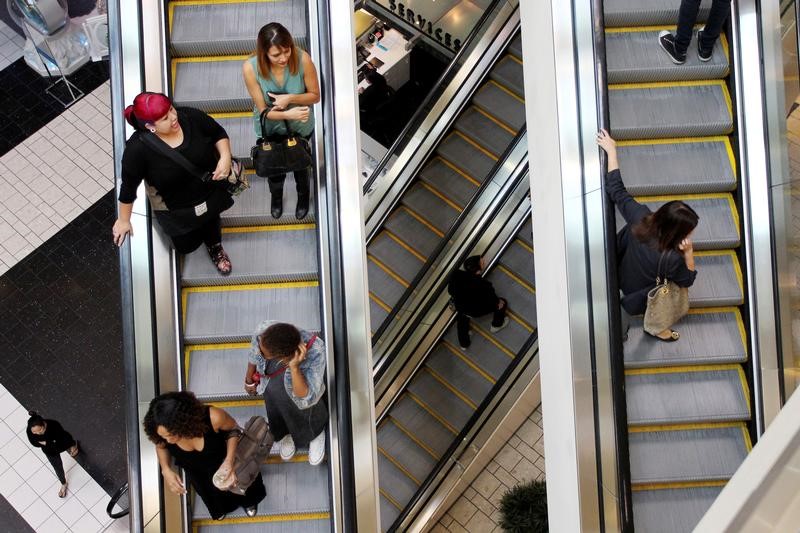
FILE PHOTO: Shoppers ride escalators at the Beverly Center mall in Los Angeles, California, U.S., November 8, 2013. REUTERS/David McNew/File Photo
July 31, 2018
By Lucia Mutikani
WASHINGTON (Reuters) – U.S. consumer spending increased solidly in June as households spent more at restaurants and on accommodation, building a strong base for the economy heading into the third quarter, while inflation rose moderately.
Other data on Tuesday showed employers boosting benefits for workers in the second quarter, but wage growth slowed down. With savings at lofty levels and lower taxes increasing take-home pay for some workers, spending is likely to remain strong this year. Accelerating home prices, which are boosting wealth for some households, should also underpin consumption.
Strong economic growth and steadily rising inflation are likely to allow the Federal Reserve to continue gradually raising interest rates. Fed officials started a two-day meeting on Tuesday.
“More spending on ‘wants,’ not ‘needs,’ is always a good sign of consumer confidence,” said Jennifer Lee, a senior economist at BMO Capital Markets in Toronto. “As long as incomes continue to rise and job creation remains strong, consumer spending should remain solid over the remainder of the year.”
The Commerce Department said consumer spending, which accounts for more than two-thirds of U.S. economic activity, rose 0.4 percent last month. Data for May was revised up to show consumer spending advancing 0.5 percent instead of the previously reported 0.2 percent gain.
Last month’s increase in consumer spending was in line with economists’ expectations. The data was included in last Friday’s second-quarter gross domestic product report, which showed consumer spending accelerating at a 4.0 percent annualized rate during that period after a pedestrian 0.5 percent pace in the first quarter.
The economy grew at a 4.1 percent rate in the second quarter, almost double the January-March period’s 2.2 percent pace and the strongest performance in nearly four years. June’s increase in consumer spending sets it on a higher growth path heading into the third quarter.
Consumer spending last month was boosted by spending at restaurants and on accommodation. Spending on services accelerated 0.6 percent after rising 0.3 percent in May. Outlays on goods were unchanged after surging 0.9 percent in May.
Prices continued to steadily rise last month. The personal consumption expenditures (PCE) price index excluding the volatile food and energy components gained 0.1 percent in June. It had risen by 0.2 percent in the prior month.
That kept the year-on-year increase in the so-called core PCE price index at 1.9 percent for a third straight month.
The core PCE index is the Fed’s preferred inflation measure. The core PCE hit the U.S. central bank’s 2 percent inflation target in March for the first time since December 2011.
The Fed is expected leave interest rates unchanged on Wednesday after increasing borrowing costs in June for the second time this year. It has forecast two more rate hikes by December.
“For the Fed, there’s nothing to be alarmed about in this morning’s data,” said Chris Low, chief economist at FTN Financial in New York. “Consumers are behaving and inflation is stable.”
The dollar firmed marginally against a basket of currencies. Prices for longer-dated U.S. Treasuries rose and stocks on Wall Street were trading higher.
LONG WAGE RECOVERY
Spending in June was supported by a 0.4 percent increase in personal income, which matched May’s increase. Savings edged up to $1.050 trillion last month from $1.047 trillion in May.
In a separate report on Tuesday, the Labor Department said its Employment Cost Index, the broadest measure of labor costs, rose 0.6 percent after an unrevised 0.8 percent advance in the first quarter. That pushed the annual increase in the ECI to 2.8 percent, the biggest gain since the third quarter of 2008, from 2.7 percent in the first quarter.
Wages and salaries, which account for 70 percent of employment costs, rose 0.5 percent in the second quarter, retreating from a 0.9 percent surge in the January-March period. Wages and salaries were up 2.8 percent in the 12 months through June, also the biggest annual gain since the third quarter of 2008.
“The long recovery in wages has reflected a large pool of workers on the sidelines,” said Adam Ozimek, a senior economist at Moody’s Analytics in West Chester, Pennsylvania. “One factor leaning against a return to rapid wage growth is weaker productivity.”
Separately, the Conference Board said its consumer confidence index increased 0.3 point to a reading of 127.4 in July. Consumers were upbeat about the labor market.
The survey’s so-called labor market differential, derived from data about respondents who think jobs are hard to get and those who think jobs are plentiful, increased to 28.1 this month from 25.3 in June. That measure closely correlates to the unemployment rate in the Labor Department’s employment report and is consistent with rapidly diminishing labor market slack.
Despite their strong confidence in the economy, consumers appeared less enthusiastic about buying a home and household appliances. Still, the fundamentals for consumer spending remain strong.
A fourth report on Tuesday showed the S&P/Case-Shiller 20-city composite price index rose 6.5 percent year-on-year in May after increasing 6.7 percent in April.
(Reporting by Lucia Mutikani; Editing by Andrea Ricci)
